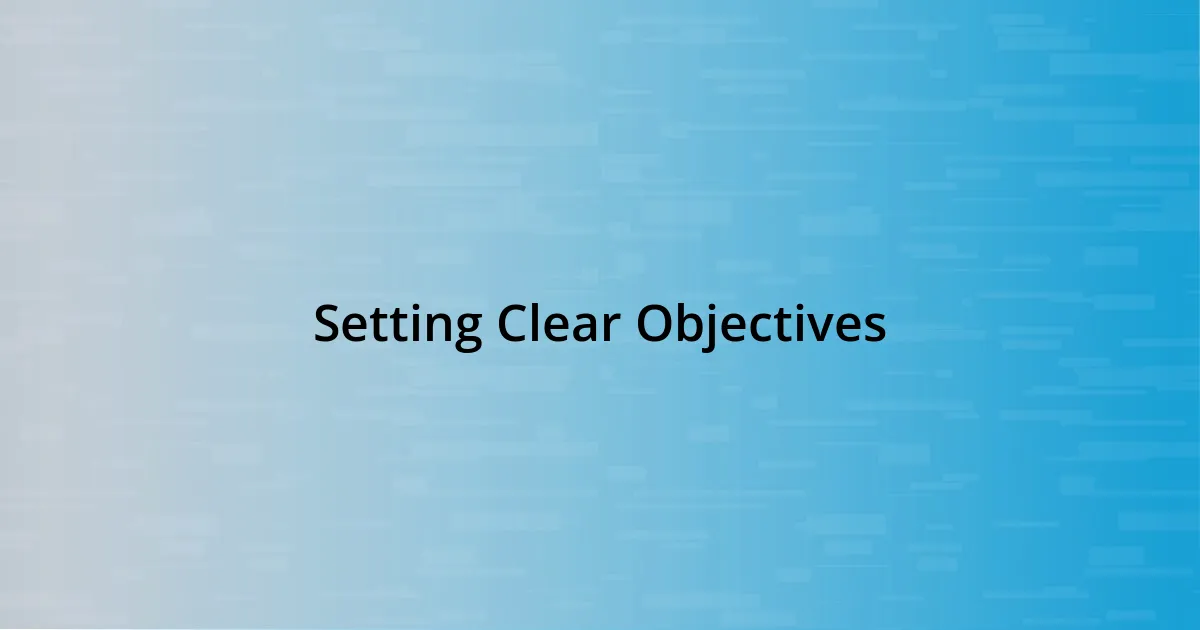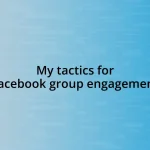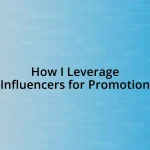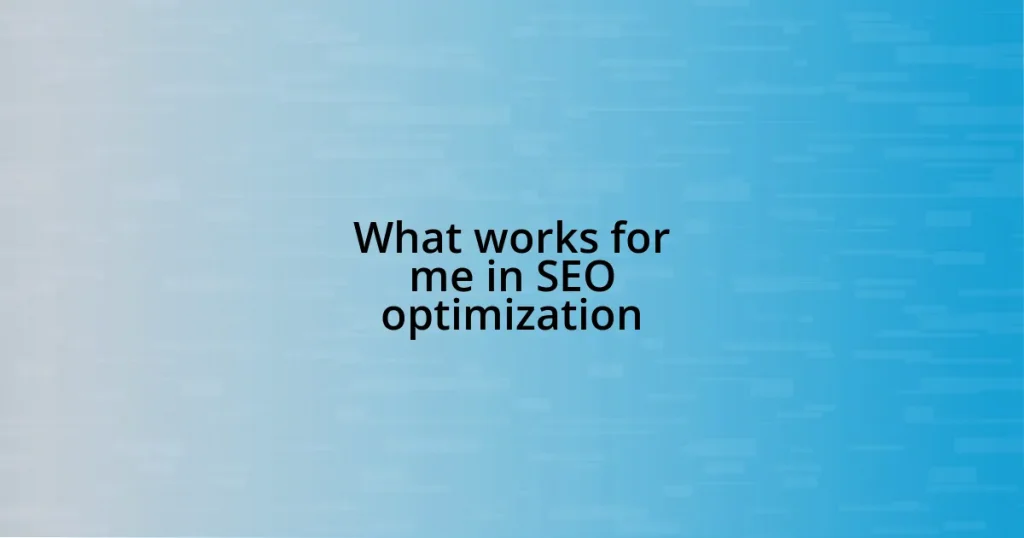Key takeaways:
- Email marketing is about building relationships and understanding your audience through buyer personas and tailored content.
- Setting clear, measurable objectives is essential for tracking progress and success in email campaigns.
- Automating campaigns and personalizing messages based on subscriber behavior enhances engagement and conversions.
- Regular analysis of metrics and audience feedback helps optimize future campaigns and refine strategies for better results.

Understanding Email Marketing Basics
Email marketing revolves around building relationships with your audience. I remember the first time I sent out my own campaign—I was both excited and nervous. Watching those open rates climb felt like a little victory, and I realized how much potential there was to connect with people directly in their inboxes. Isn’t it fascinating how a simple email can spark engagement and loyalty?
At its core, email marketing involves sending targeted messages to defined segments. This means understanding who your audience is and what they want. I often find myself pondering: how do I ensure my message resonates with them? Creating buyer personas has been a game-changer for me. It allows me to tailor content so I’m speaking directly to my audience’s needs, making it far more effective.
Tracking metrics such as open rates, click-through rates, and conversions is essential in refining your strategy. I recall a time when I noticed a dip in my click-through rates and asked myself what went wrong. After a quick analysis, I realized my subject line wasn’t enticing enough. This moment taught me the powerful impact of every detail and reinforced my commitment to continual improvement in my email marketing efforts. How do you keep your campaigns fresh and engaging?

Setting Clear Objectives
Setting clear objectives is the backbone of any successful email marketing strategy. I vividly remember a campaign where I set the objective to increase my newsletter sign-ups by 30% over three months. Having that specific target kept me focused, and every time I crafted a message, I constantly measured its effectiveness against that goal. It felt rewarding to witness progress and adjust tactics as needed.
To establish clear objectives, consider these key points:
- Define what success looks like for your campaign (e.g., increase sales, boost engagement).
- Make your objectives measurable, allowing for easy tracking and assessment.
- Set realistic timelines that motivate ongoing efforts without adding unnecessary pressure.
When I took the time to sit down and articulate my goals clearly, the outcomes often exceeded my expectations. It’s that clarity that drives all subsequent decisions and strategies, creating a road map toward my desired results.

Building a Targeted Email List
Building a targeted email list is both an art and a science. I recall when I first embarked on this journey; it felt like searching for hidden treasures. Instead of just gathering emails, I focused on attracting individuals genuinely interested in what I had to offer. One effective method I discovered was offering incentives, like exclusive content or discounts, to encourage sign-ups. It was like sending out invitations to a special club—making people feel valued and eager to join.
As I refined my approach, segmentation became a crucial part of my strategy. I realized that not everyone on my list had the same interests or needs. By categorizing my contacts based on their behaviors and preferences, I could send tailored messages that resonated deeply. For example, I have a group of subscribers who are keen on DIY projects and another cluster that prefers tips on digital marketing. The difference in engagement was noticeable; messages crafted specifically for each segment resulted in higher open rates and conversions. Seeing those numbers soar was like a high-five from my audience!
It’s essential to maintain the quality of your list. I often run through my subscribers and weed out inactive accounts. After all, having a smaller, engaged list is much more valuable than a large, disinterested one. This practice not only keeps my emails reaching enthusiastic readers but also boosts my credibility. Why should I bother engaging with those who aren’t interested? I relayed this lesson to my friends, and they too saw the benefits of trimming their lists for quality over quantity.
| Strategy | Details |
|---|---|
| Incentives | Offering exclusive content or discounts encourages sign-ups from interested users. |
| Segmentation | Dividing your list into groups allows for tailored messaging, increasing engagement. |
| List Maintenance | Regularly removing inactive subscribers ensures a high-quality, engaged email list. |

Crafting Compelling Email Content
Crafting email content that truly resonates with your audience can be a transformative experience. I remember the first time I infused my personality into my newsletters; it felt like welcoming friends into my space. Instead of being overly formal, I adopted a conversational tone, sharing stories from my day-to-day life that related to the topics at hand. It’s fascinating how a simple shift in tone can lead to a surge in reader engagement—people didn’t just read my emails; they eagerly anticipated them.
To keep that momentum going, I learned the importance of a compelling subject line. I often think of these lines as book covers—wouldn’t you decide whether to pick up a book based on its cover? One day, I tested a catchy subject line that included a playful pun, and I saw a notable increase in open rates. It made me realize how crucial first impressions are, even in the inbox. A well-crafted subject line not only piques curiosity but can also set the stage for the value offered within.
Finally, I strive to incorporate a clear call to action in every email. Early on, I made the mistake of being vague, leaving my readers unsure of the next steps. It was disappointing to see high open rates but low click-through rates. Then I started crafting specific asks, like “Click here to receive your exclusive guide!” The change was remarkable. People responded better when I clearly outlined what I wanted them to do. It’s a game-changer, knowing that clarity can drive results—what do you want your readers to take away from your email? Your call to action should guide them there.

Automating Your Email Campaigns
Automating your email campaigns can feel like a secret weapon in your marketing arsenal. When I first delved into automation, I was amazed at how it transformed my workload. Imagine setting up a series of welcome emails that nurture new subscribers effortlessly. I remember feeling a sigh of relief the moment I realized I could engage with my audience while I focused on other projects. It’s like having a smart assistant working around the clock, ensuring no subscriber feels neglected.
One key aspect that struck me in my automation journey was personalization. I scheduled emails that catered to subscribers’ actions—like follow-up messages based on their last interaction. For instance, after someone downloaded a resource from my site, they received an automated email with tips related to that content just a day later. It felt so rewarding to see my audience engage more meaningfully because I was speaking directly to their interests. Wouldn’t you agree that it’s far more powerful to receive an email that feels tailor-made for you?
After testing various automation tools, I found that segmenting my automated lists not only streamlined my process but also enhanced my effectiveness. I incorporated triggers based on user behavior, which allowed me to send timely offers that aligned with their interests. For example, someone interested in fitness received tips and promotional content tailored to that theme. I vividly recall the excitement when I saw those targeted emails lead to conversions—like shooting fish in a barrel! It reinforced my belief that, with the right automation strategy, you can create genuine connections with your audience, even without being there in person.

Analyzing Email Marketing Results
Analyzing email marketing results is where the magic really happens. In my journey, I discovered the joy of deep diving into metrics like open and click-through rates. I remember sitting one afternoon, coffee in hand, poring over the analytics dashboard. It struck me how certain campaigns had outperformed others, and I couldn’t help but feel a thrill at spotting patterns. Was it the subject lines or the timing? It became an addictive puzzle, unlocking insights into my audience’s preferences.
One particular campaign sticks out in my mind. I thought I had crafted a gem of an email, but the stats told a different story—low engagement. After some reflection, I realized I hadn’t segmented my audience effectively; I was sending a one-size-fits-all message instead of tailoring the content to different interests. It was an eye-opener! Now, when reviewing results, I consistently ask, “What can I learn from this?” I’ve found that every dataset holds a story, and it’s my job to uncover the narrative behind the numbers.
Another critical area I evaluate is audience feedback. I often include a simple question at the end of my emails, such as, “What topics do you want to hear about next?” It’s surprising how many readers respond. Their insights guide my future content and make them feel valued, which ultimately fosters a deeper connection. So, when you’re analyzing your results, consider reaching out. What if your audience could help shape your email strategy? That, to me, is a beautiful synergy and a testament to the power of effective email marketing.

Optimizing for Future Campaigns
Optimizing future email campaigns involves a keen analysis of past performance. I often find that refining subject lines is a dynamic way to boost open rates. I distinctly remember a campaign where I shifted from a generic title to something more provocative—”Unlock Your Potential!” Suddenly, my open rates soared, and I couldn’t help but feel a rush of exhilaration. Who doesn’t want to tap into that potential?
As I plan my next moves, I make it a point to clearly define my goals for each campaign. During one campaign, I set out to increase my engagement rate, and I focused specifically on call-to-action buttons. By testing various placements and colors, I ended up with a design that not only caught the eye but also led to a noticeable uptick in clicks. Aren’t those small tweaks often the biggest game changers? I genuinely love witnessing firsthand how these adjustments can create a more compelling experience for my subscribers.
I find that collecting data is just part of the equation. It’s crucial to translate those insights into action. For instance, I like to run A/B tests on different email formats or content types. One time, I split my audience and sent one group a video email while the other received a traditional text layout. The video email had a much higher engagement rate, and it was a valuable lesson in visual storytelling for me. How often do we underestimate the impact of visuals? By embracing such experiments, I feel empowered to deliver content that resonates with my audience, making them more likely to engage—and ultimately, that’s what it’s all about.















